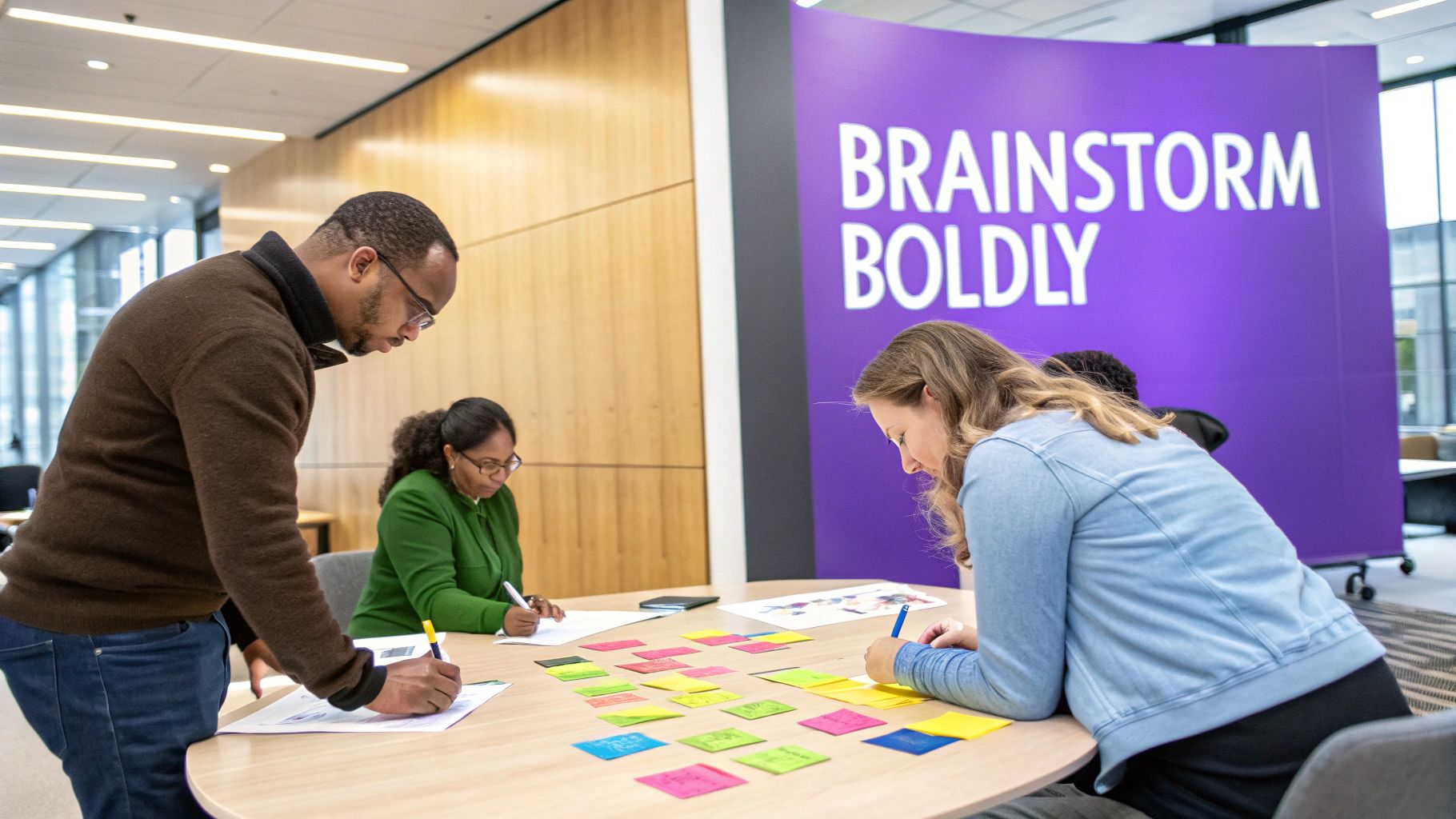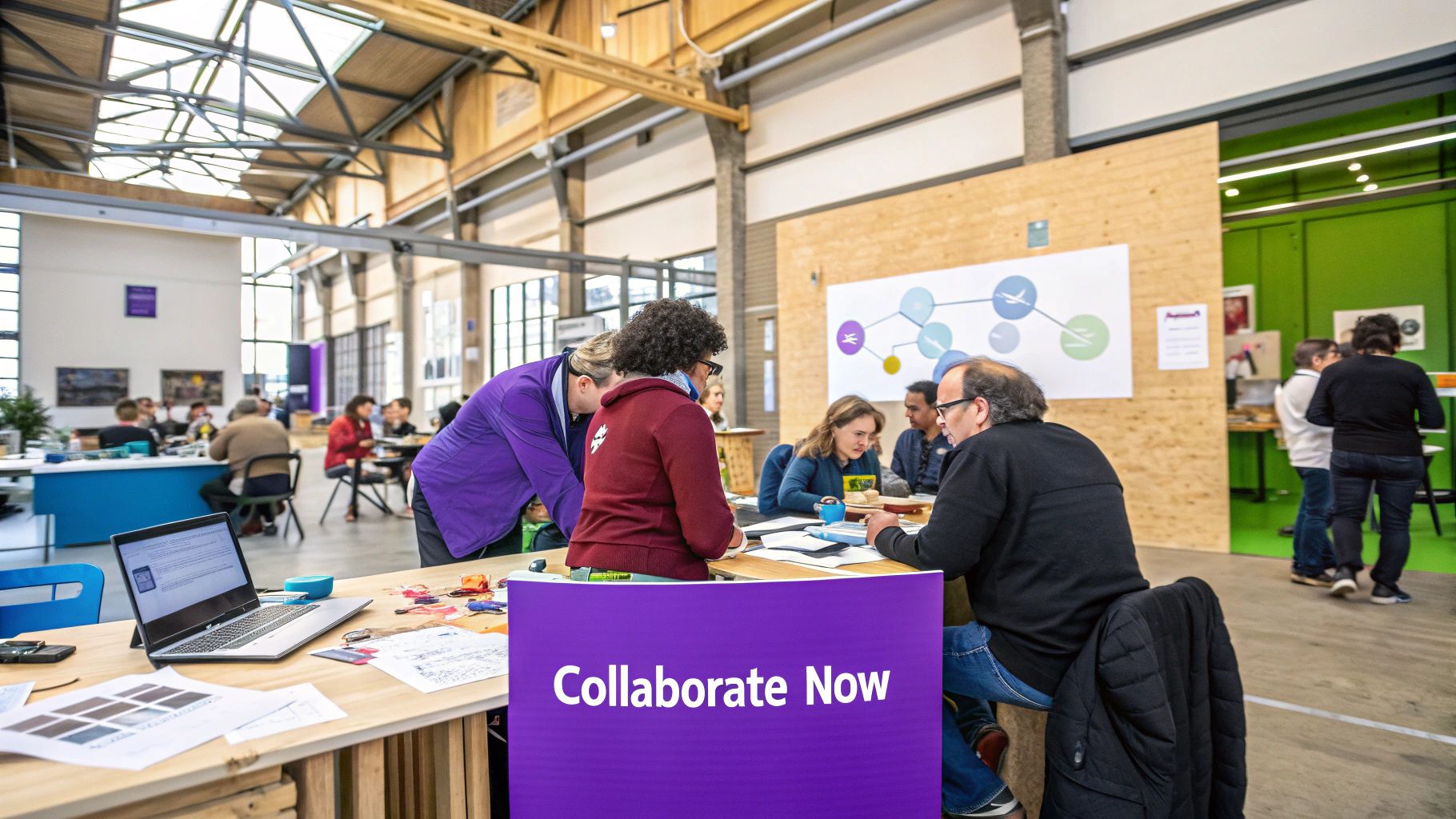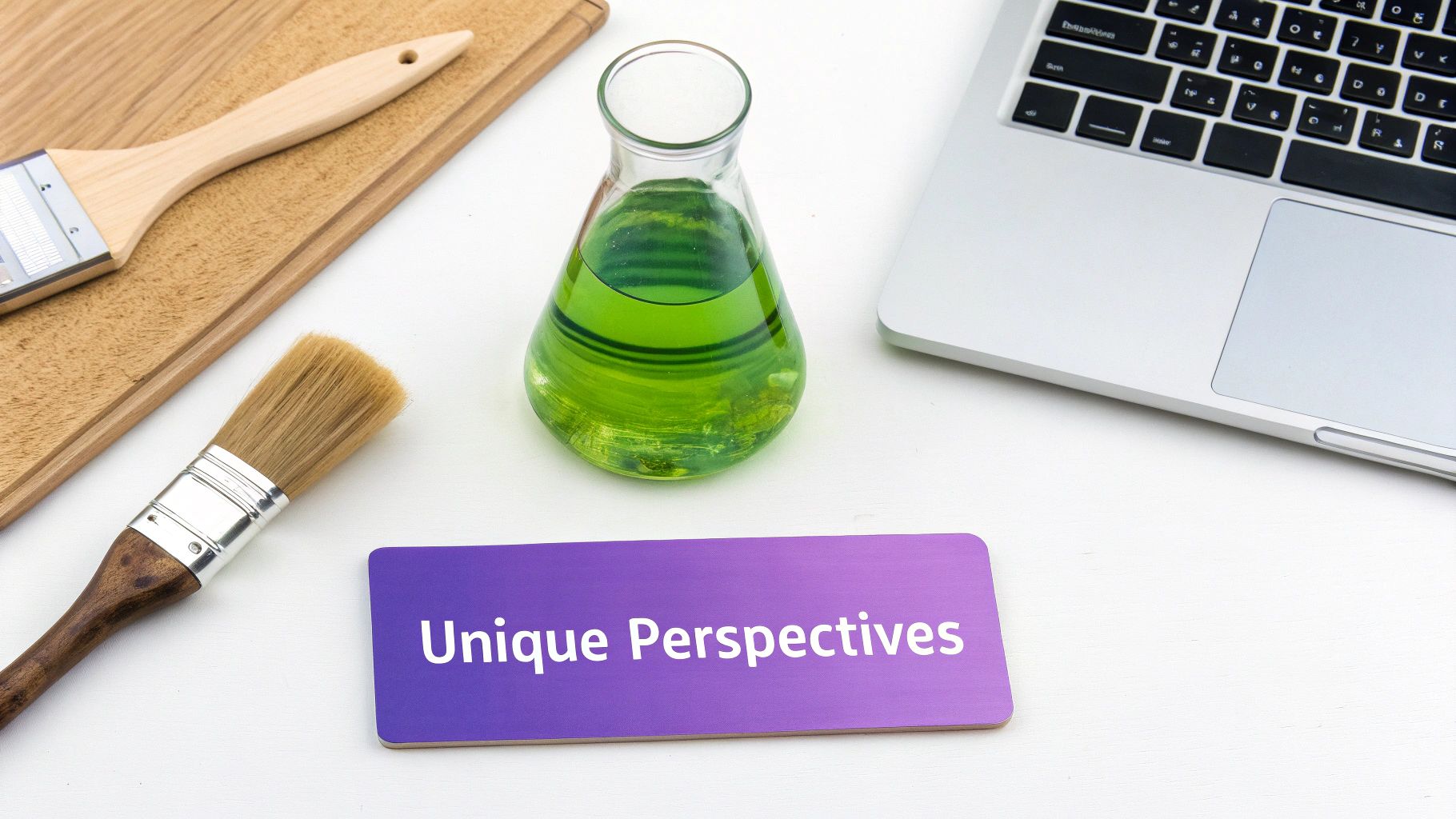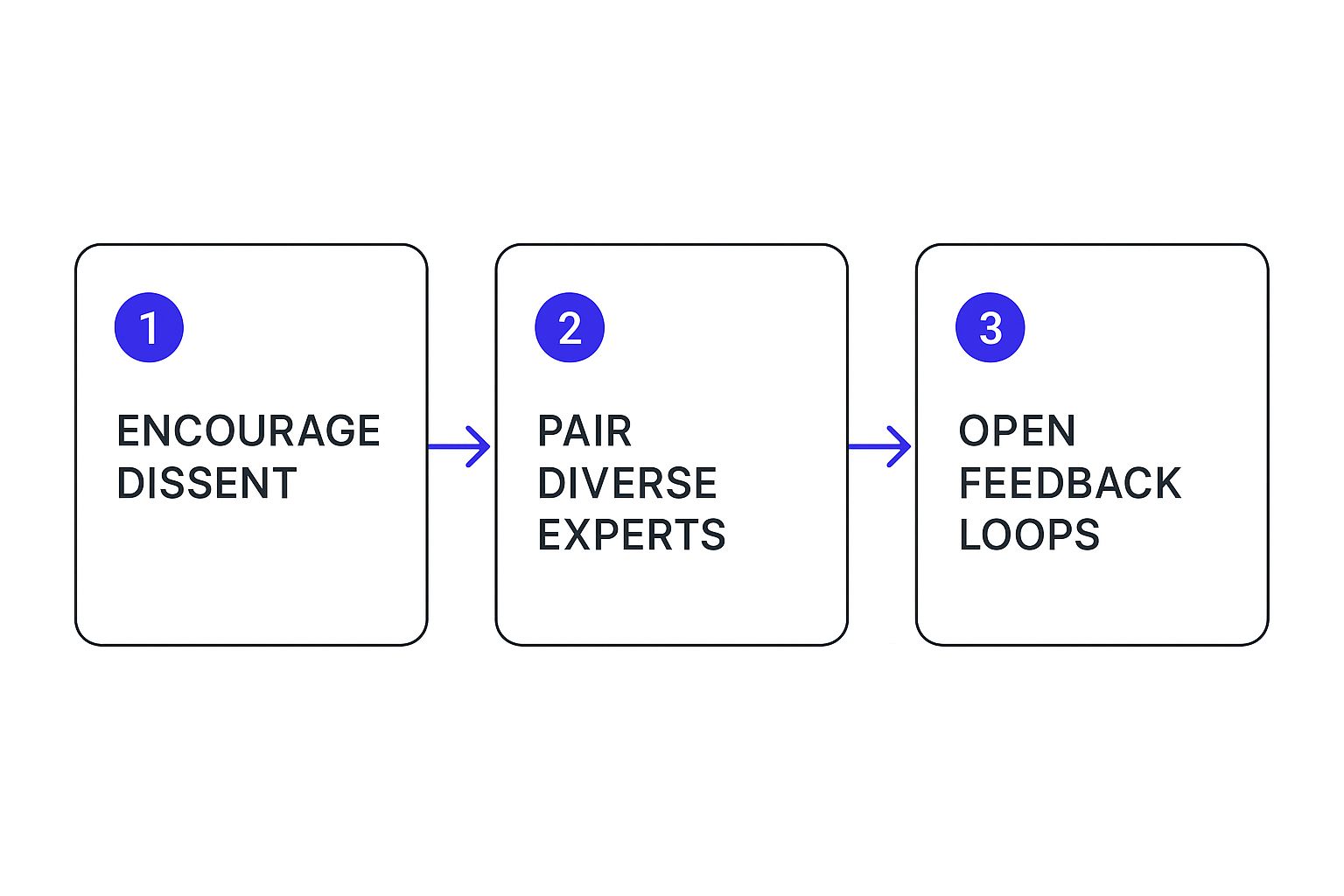Think of a chef. If you give them only salt and flour, they can make bread. But if you give them a pantry bursting with spices, herbs, vegetables, and proteins, they can create a culinary masterpiece. That’s the difference diversity of ideas makes. It’s the secret ingredient that comes from mixing different viewpoints, life experiences, and problem-solving styles.
Unlocking Innovation with Idea Diversity

Real innovation isn’t born from a single lightbulb moment. It’s usually pieced together from a rich collection of different thoughts and possibilities. This is where a diversity of ideas becomes so critical, especially for teams wrestling with tough business problems.
It’s about more than just having people with different job titles in a room. It’s about intentionally inviting unique life stories, cultural backgrounds, and thinking patterns to the conversation. The goal isn’t just to get more ideas; it’s to get different kinds of ideas. This variety is your best defense against the echo chamber of stale thinking that can quietly sink a project. It helps you question assumptions and see the blind spots you’d otherwise miss.
The Power of Volume and Variety
One of the golden rules of creative problem-solving is to generate a ton of ideas before you start judging them. Your first idea is rarely your best one. It’s crucial to come up with many different ideas before picking the solution you’ll go forward with. Pushing for a wide range of options forces your team to look beyond the obvious answers and explore completely new territory.
The real magic happens when you stop searching for one perfect solution and start building a portfolio of diverse possibilities. This shift in mindset moves teams from a state of pressure to one of creative exploration.
This isn’t just a feel-good concept; it’s a proven business driver. The World Economic Forum’s DEI Lighthouse program has seen submissions from over 20 countries, showing a global commitment to using diverse perspectives to fuel innovation and growth.
To truly appreciate what idea diversity brings to the table, it helps to break it down. It’s not just one thing, but a combination of different layers that work together.
Core Components of Idea Diversity
| Component | Description | Example in a Team Setting |
|---|---|---|
| Cognitive Diversity | Differences in how people think, process information, and solve problems. | An analytical, data-driven marketer and a creative, big-picture designer brainstorming a new campaign. |
| Experiential Diversity | The unique knowledge and skills gained from different life paths, jobs, and personal histories. | A team member who grew up in another country offers a fresh perspective on a product’s global appeal. |
| Demographic Diversity | Differences in age, gender, ethnicity, and other social identity markers. | A multi-generational team combines the digital fluency of younger members with the industry wisdom of veterans. |
Each of these components adds a unique flavor to the mix, strengthening the team’s overall ability to innovate.
From Concept to Action
When you really grasp the benefits of idea diversity, you see how it makes creativity and problem-solving accessible to everyone. It’s a lot like how new technologies are breaking down barriers in other fields. For instance, understanding How No Code Makes Innovation Accessible to Everyone shows a similar trend—empowering more people to build unique solutions without needing specialized skills.
By truly embracing a diversity of ideas, your team can unlock some serious advantages:
- Richer Problem-Solving: You can attack challenges from every angle, leading to more complete and resilient solutions.
- Increased Innovation: A bigger pool of ideas directly leads to finding game-changing new products, services, and ways of working.
- Enhanced Adaptability: When your team is used to hearing different viewpoints, it becomes more agile and ready to pivot when the market throws a curveball.
How Diverse Thinking Leads to Better Decisions

It’s easy for a team to latch onto the first good idea that pops up. It feels fast, decisive, and efficient. But moving too quickly often means leaving incredible, more creative solutions completely on the table. The real magic of having a diversity of ideas is about intentionally building a big pool of possibilities before you even think about making a choice.
Think of it like building with LEGOs. If all you have are red 2×4 bricks, sure, you can build something, but your options are pretty limited. Now, imagine dumping an entire bin full of different colors, shapes, and sizes onto the floor. The potential for what you can create becomes almost endless. Rushing to a conclusion is like grabbing the first brick you touch; exploring many ideas is like taking the time to see all the pieces you have to work with.
This process of generating a ton of different ideas is the bedrock of better decision-making. It nudges the team past their default assumptions and forces them to look at the problem from angles they never would have considered otherwise.
The Business Case for Varied Viewpoints
Encouraging different ways of thinking isn’t just a nice-to-have cultural perk; it directly impacts the bottom line. It’s no coincidence that companies known for fostering a true diversity of ideas also see better business results, from more imaginative marketing campaigns to sturdier product designs.
When you bring together people with different problem-solving methods, life experiences, and professional backgrounds, you create a team with fewer blind spots. What seems like an “obvious” solution to one person becomes a starting point for critical questions from another.
The data backs this up. Studies consistently show that organizations with greater racial and ethnic diversity often have better financial returns than their less diverse competitors. It’s not just about demographics—it’s about the rich variety of perspectives that fuels more robust and creative problem-solving.
Your Best Defense Against Groupthink
One of the sneakiest risks to smart decision-making is groupthink. This is what happens when a team values harmony over honesty, causing people to stay quiet instead of challenging the consensus. A genuine diversity of ideas is the perfect antidote.
When everyone feels genuinely encouraged to share their unique perspective—especially if it goes against the grain—it short-circuits that natural pull toward easy agreement. This healthy friction is exactly where innovation thrives. It pushes the team to justify its reasoning, poke holes in its own logic, and ultimately land on a decision that is stronger and more thoroughly examined. To build a team that avoids this pitfall, you have to know how to prevent groupthink before it ever starts.
By making a deliberate effort to gather a wide range of ideas before narrowing down the options, you aren’t just being inclusive. You’re building a powerful strategic advantage that shields your team from flawed thinking and unlocks its true potential.
How to Grow Idea Diversity in Your Remote Team

When your team is spread out, getting a true diversity of ideas can be tough. It’s not like the old days where everyone was in the same room. In a remote setup, it’s all too easy for the loudest voices—or maybe just the people in the most convenient time zones—to dominate the conversation.
This means brilliant perspectives can get lost in the shuffle. The trick is to be deliberate about creating an environment where every single person feels they can speak up.
You can’t just try to copy your old in-office brainstorming sessions over a video call. It doesn’t work. Instead, the best remote teams use technology to their advantage, creating multiple ways for people to share their thoughts that fit different schedules and communication styles.
Build Your Virtual Sandbox
First things first: you have to accept that not everyone does their best thinking in a fast-paced, on-the-spot brainstorm. Some of your most brilliant people might be introverts or just need a little quiet time to chew on an idea before they share it. If you force everyone into the same box, you’ll always get a limited range of ideas.
A remote team’s greatest strength is its ability to operate asynchronously. By creating spaces where ideas can be shared over time—not just in a one-hour meeting—you invite deeper, more considered contributions from everyone.
This is where the idea of a “virtual sandbox” comes in. It’s all about creating a digital space where different kinds of participation are not just allowed, but actively encouraged. You’re designing an inclusive environment from the ground up.
Here are a few ways to do it:
- Virtual Whiteboards: Tools like Miro or Mural are fantastic for this. They let everyone map out thoughts together in real-time, just like you would on a physical whiteboard.
- Asynchronous Channels: Set up a dedicated channel in Slack or Teams for a specific project. This gives people a place to drop ideas, links, or comments whenever inspiration hits, no matter what time it is.
- Structured Documents: A simple shared Google Doc with clear questions or prompts works wonders. It lets team members add their thoughts in a more organized way, which is perfect for those who prefer to write things out.
The Diversity Architect Framework
When you intentionally design your team’s digital space like this, you’re acting as a Diversity Architect. You’re building a system that breaks down barriers and makes it easy for a true diversity of ideas to flourish. Technology is your best friend here.
With 25-30% of the U.S. workforce expected to work from home regularly, more companies are looking for smart ways to make their virtual spaces more inclusive. Some are even using AI to analyze communication patterns and flag unconscious bias in feedback. You can explore more of these trends and get additional insights into diversity and inclusion from Vantage Circle.
To really unlock your team’s potential, try introducing some structured activities. These aren’t just icebreakers; they’re research-backed methods designed to get people thinking differently. By using proven creative thinking exercises, you can guide your team to explore unconventional ideas and make sure every voice contributes to the final outcome.
When you do this, your remote setup stops being a challenge and starts becoming your biggest competitive advantage.
A Practical Guide to Generating More Ideas
If you want to unlock a true diversity of ideas, you can’t just sit around waiting for a lightning bolt of inspiration. It’s a deliberate process that starts with one simple rule: quantity over quality. The biggest mistake I see teams make is shooting down ideas as soon as they’re suggested. This puts the brakes on creativity and makes people self-censor, only sharing the “safe” or obvious thoughts.
To land on a truly game-changing solution, you first need a mountain of raw material to sift through. It’s incredibly important to come up with many different ideas before deciding which one to pursue. Think of it like a prospector panning for gold. They don’t just grab one rock and hope it’s valuable. They scoop up pounds of dirt and gravel, knowing most of it is useless, just to find those few shiny nuggets. Your initial goal is volume—get every possible concept out on the table before you even think about which ones are “good.”
The Diverge and Converge Mindset
The best way to keep evaluation from killing creativity is to adopt a “Diverge and Converge” mindset. This just means you break your problem-solving into two very distinct phases.
- Diverge: This is the “anything goes” part. Your only mission is to generate as many ideas as possible, no matter how wild or off-the-wall they might seem. Judgment is officially on hold.
- Converge: This is the analytical, decision-making part. Only after you have a huge list of ideas do you switch gears to start sorting, combining, and prioritizing them.
Splitting up the process like this is key for psychological safety. When team members know their initial thoughts won’t be immediately judged, they feel much more comfortable sharing those half-baked or “silly” ideas that often hide the seeds of real innovation.
Structured Techniques for Inclusive Ideation
Let’s be honest: a classic, free-for-all brainstorm usually favors the loudest or most senior person in the room. Structured methods are the great equalizer, making sure everyone gets a chance to contribute.
This flow chart breaks down how you can systematically draw out, blend, and polish ideas to get the absolute most from your team’s collective brainpower.

The big takeaway here is that incredible ideas are rarely a “eureka!” moment from one person. They’re built through a conscious process of encouraging different viewpoints, connecting diverse experts, and creating safe feedback channels.
To get started, here’s a look at a few structured brainstorming techniques that can help you create a more inclusive environment for idea generation.
Brainstorming Techniques for Inclusive Idea Generation
| Technique | Best For | How It Works |
|---|---|---|
| Brainwriting | Giving introverts a voice and preventing groupthink. | Team members silently write down ideas on paper for a few minutes. Then, they pass their papers to someone else, who adds to or builds upon the existing ideas. |
| Round Robin | Ensuring everyone participates equally. | The facilitator goes around the room (or virtual room) one by one, asking each person to share one idea. Participants can “pass” if they have nothing to add at that moment. |
| Reverse Brainstorming | Identifying potential problems or challenges with an existing idea or plan. | Instead of asking “How do we solve this problem?”, the team asks “How could we cause this problem?” or “How could this plan fail?” This helps uncover risks proactively. |
Each of these methods offers a unique way to structure the conversation, ensuring that the best ideas can surface, regardless of who they come from.
One of the most effective methods is Brainwriting. Instead of people shouting out ideas, team members spend a few minutes writing them down silently. Then, they pass their notes to a teammate, who uses them as inspiration to build even more ideas. This quiet, reflective process gives deep thinkers and introverts the space they need to contribute just as effectively as the more vocal members of the team. For more inspiration, you can explore several other powerful idea generation techniques to see what fits your team’s style.
The core principle is simple: separate the act of creating from the act of judging. By doing so, you give your team permission to explore the full spectrum of possibilities, which is the foundation of a true diversity of ideas.
Once you have a system for generating a wide variety of concepts, the next challenge is finding ideas that actually work and solve real problems. This crucial step ensures all that creative energy is pointed toward something meaningful and impactful.
Overcoming Common Barriers to Idea Diversity
Even when we have the best intentions, getting a true diversity of ideas is tough. A few invisible forces can quietly steer creative sessions back toward the same old, safe solutions. The first step to breaking free is simply recognizing what these barriers are. Only then can we build an environment where every voice truly matters.
One of the biggest culprits? Rushing. Teams often feel pressured to land on the perfect answer right away. But the real magic happens when you generate a ton of different ideas before you even think about picking a winner. This initial, no-holds-barred brainstorming is where breakthroughs are born.
Confronting Unconscious Bias
We all have unconscious biases. It’s just human nature to gravitate toward ideas that feel familiar or come from people who think like us. The danger is that this can cause us to dismiss a brilliant, unconventional idea without giving it a fair shake.
A great way to fight this is with anonymized idea reviews. When you strip the names away from the suggestions, people are forced to judge them purely on merit. It levels the playing field, making sure an idea from a brand-new hire gets the same consideration as one from a senior director. The focus shifts from who said it to what was said.
Defeating Groupthink and Silence
Groupthink is the quiet killer of creativity. It’s that subtle pressure to agree with the group to maintain harmony, where nobody wants to be the one to rock the boat. This is especially true in teams with a clear hierarchy, as junior members might not feel comfortable questioning a manager’s proposal.
To prevent a suffocating uniformity of views, you must create systems that actively encourage dissent. Healthy disagreement isn’t a sign of conflict; it’s a sign that your team is engaged enough to push for the best possible outcome.
Try formally assigning a “devil’s advocate” for big decisions. This person’s only job is to challenge the popular opinion and poke holes in the plan. By making constructive criticism an official part of the process, you take away the social risk of speaking up and encourage a much healthier debate. This is a crucial tactic for fostering innovation in remote teams, where these subtle pressures can be even harder to notice.
Building a Truly Open Environment
At the end of the day, all of this comes down to building psychological safety. Your team needs to feel confident that they can share a half-baked thought or point out a potential problem without being shut down. This bedrock of trust is what allows a real diversity of ideas to flourish.
Here are a few practical ways to find and fix the hidden issues that might be holding your team back:
- Try Anonymous Brainstorms: Use a digital whiteboard or tool that lets people add ideas without attaching their names.
- Rotate Who Leads: Don’t let the same person facilitate every creative meeting. Different leaders bring different energy and can draw out different voices.
- Celebrate “Good” Failures: When a bold experiment doesn’t work out, praise the team for taking a smart risk. This shows that you value the courage to explore, not just the wins.
Alright, you’ve successfully opened the floodgates and a torrent of ideas is pouring in. This is fantastic! But this is also where many teams get stuck.
Faced with a mountain of possibilities, the natural tendency is to get overwhelmed and retreat to the most familiar or “safest” option. Doing that would waste all the hard work you just put into generating genuine diversity of ideas. A huge pool of ideas is an asset, not a problem. Remember, your first thought is rarely your best one. Now, you just need a system to find the real gems.
Create Objective Evaluation Criteria
Before you even start discussing individual ideas, stop. The very first step is for the team to agree on how you’ll judge them. What does a “winning” idea actually look like for this specific project?
Get on the same page by defining your core criteria. Think about:
- Impact: How much will this idea really move the needle on our key goals?
- Feasibility: Can we realistically pull this off with the time, budget, and skills we have right now?
- Alignment: Does this idea fit with our company’s mission and where we’re headed long-term?
Having clear, pre-defined criteria acts as a guardrail against unconscious bias. It forces everyone to evaluate ideas based on merit, not on who suggested them or how familiar they feel.
To truly turn these concepts into a solid plan, you’ll need to see if they hold up outside your team’s bubble. Understanding essential market research types can give you the hard data you need to back up your decision and give your chosen idea the best possible chance to succeed.
Got Questions? We’ve Got Answers
Even with the best game plan, putting these principles into practice can feel tricky. Let’s tackle some of the most common questions that pop up when teams start getting serious about idea diversity.
How Can I Encourage Quieter Team Members to Speak Up?
This is a big one. It’s easy to mistake silence for a lack of ideas, but often, the quietest people have the most well-thought-out contributions. The key is to stop forcing everyone into a live, high-pressure brainstorm. Not everyone thinks best on their feet.
Here’s how you can draw out their brilliant ideas:
- Go Asynchronous: Give people space. Use a shared document, a virtual whiteboard, or a dedicated Slack channel where everyone can drop in ideas over a day or two. This gives your deep thinkers and introverts the time they need to reflect without being talked over.
- Try Brainwriting First: Before anyone says a word, have the whole team silently write down their ideas. This simple shift ensures you capture everyone’s raw thoughts before group dynamics and dominant personalities take over the conversation.
- Ask Directly (and Gently): A good leader can create an opening by saying something like, “Sarah, I’d love to get your take on this.” It’s not a confrontation; it’s an invitation that shows their perspective is genuinely valued.
What Is the Leader’s Most Important Job Here?
Above all else, a leader’s job is to build and protect psychological safety. They are the chief architect of an environment where people feel safe enough to share a half-baked thought, disagree with the boss, or propose something completely out of left field without fearing they’ll be shot down or embarrassed.
A leader sets the tone. If they only reward safe, predictable ideas, the team will stop offering up the bold ones. True leadership in this context means actively inviting and defending different viewpoints, even those that challenge their own.
This looks like stepping in to shut down dismissive comments, celebrating the courage behind an idea that didn’t work out, and always giving credit to the team for their collective brainpower.
How Can You Tell If It’s Actually Working?
Measuring idea diversity isn’t about hitting a specific number; it’s about looking at the quality and variety of your team’s thinking. You’re not just counting ideas, you’re observing their DNA.
Ask yourself these questions to see if you’re making progress:
- Are our final decisions just slightly better versions of the very first idea that was mentioned? Or are they something completely new?
- How many genuinely different paths did we explore before picking one to move forward with?
- Are the best ideas coming from the same two people every time, or are they popping up from all corners of the team?
When you have a healthy diversity of ideas, you’ll see contributions flowing from everyone. Your solutions will feel fresh and truly innovative, not just like a polished-up version of what you’ve always done.
Ready to stop talking about innovation and start building it? Bulby provides a structured, AI-guided platform that helps your remote team generate, refine, and select the best ideas. Break free from groupthink and unlock your team’s full creative potential.

